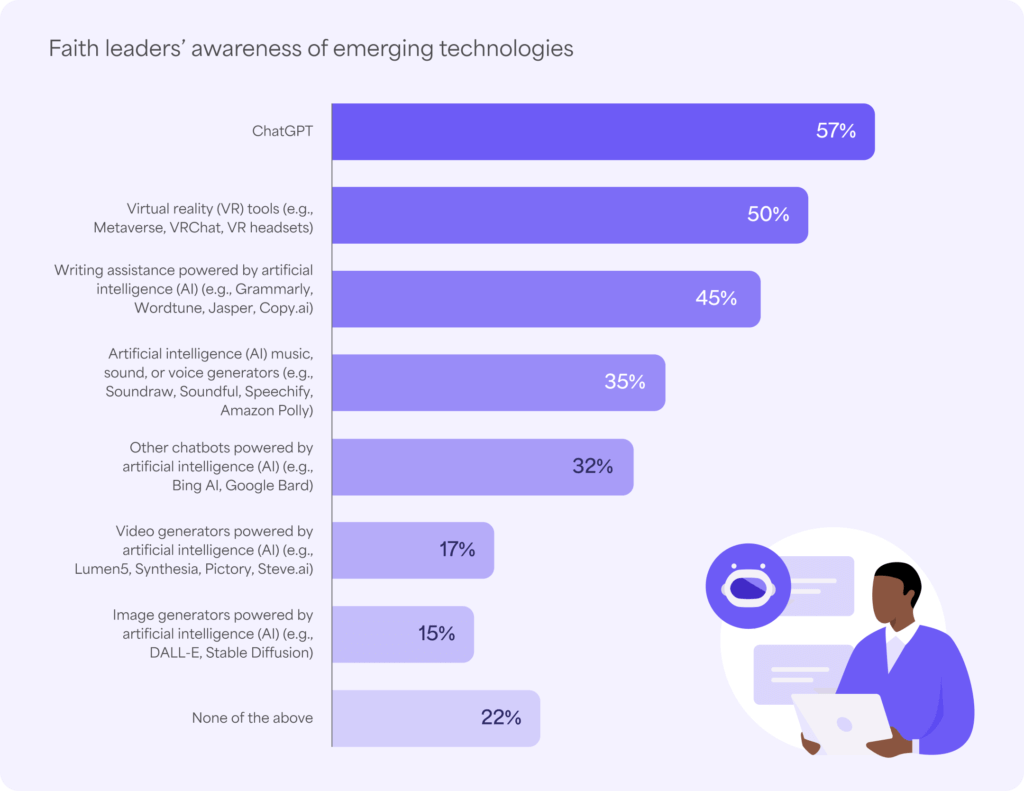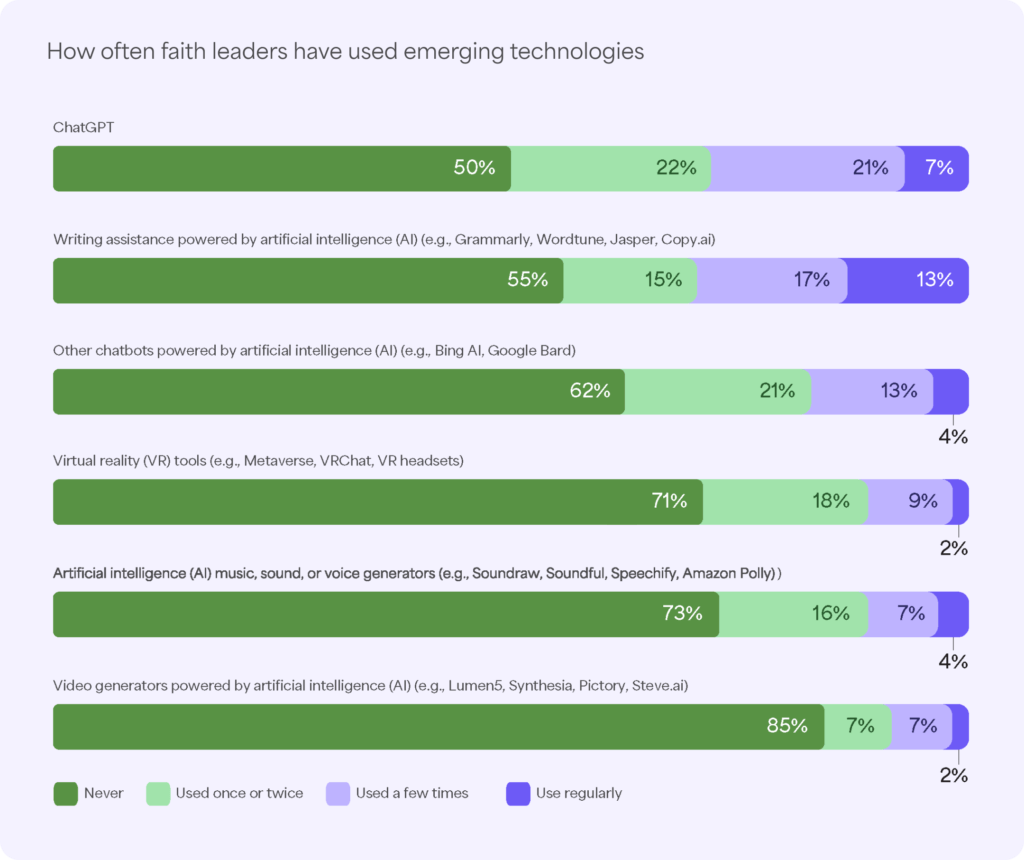Church Technology Insights: How Emerging Technologies are Reshaping Congregations

In today’s fast-paced world, technology continues to reshape every aspect of our lives. Once considered futuristic concepts, tools like artificial intelligence (AI) and virtual reality (VR) are now seamlessly integrated into everyday experiences.
Insights from the 2024 Giving in Faith report shed light on how these technologies are beginning to reshape ministry work and congregational experiences, presenting both opportunities and challenges.
Let’s explore what we’ve learned from recent data, how 2024 unfolded as a year of growth for these technologies, and practical ways your church can leverage these tools in 2025.
What we learned: Emerging technologies in faith communities
As these new technologies emerged, news of their potential impact rippled across the U.S., capturing attention nationwide. Just as Americans were learning more about tools like AI and VR, awareness was growing within faith communities too.
In late 2023, Givelify conducted a nationwide survey of faith leaders and donors to explore their perspectives on religious giving, including their awareness and attitudes toward emerging technologies. The findings featured in the 2024 Giving in Faith report revealed that 78% of faith leaders were familiar with at least one type of AI-powered or virtual reality tool.
Among these, ChatGPT, the now popular AI-powered chatbot, emerged as a standout, with more than half of respondents reporting that they were aware of the tool. Some leaders even shared that AI-driven writing tools, like ChatGPT or Grammarly, had already become a part of their toolkit.

However, adoption of these tools remained low. While these technologies sparked curiosity, a majority of faith leaders said they had yet to incorporate AI or VR tools into their work.

Despite a lack of adoption, 72% believed that technology could encourage consistent giving among their members. Still, only 29% expressed excitement about exploring the use of AI tools like ChatGPT for their congregations.
These findings highlight a cautious yet growing curiosity about how emerging technologies can support ministry efforts, particularly in fostering consistent generosity within congregations.
As we transitioned into 2024, it proved to be a pivotal year for technological growth. Rapid advancements and increasing adoption of tools like AI and VR began reshaping how these technologies are integrated into everyday life. Here’s a closer look at how these trends unfolded:
2024: A year of growth for emerging tech
The adoption of emerging technologies accelerated throughout 2024, both broadly across the U.S. and worldwide. Here’s what we saw:
AI tools on the rise
The launch of ChatGPT in November 2022 marked a milestone in AI adoption, amassing 1 million users within just five days. By 2024, its growth trajectory soared, with active users increasing by over 50% compared to the previous year. Today, ChatGPT boasts 200 million weekly users globally, with more than 67 million users in the U.S. alone. This remarkable expansion highlights AI’s rapidly growing influence on both personal and professional life.
But chatbots are only the tip of the iceberg. AI technology has become deeply integrated into every aspect of our lives. AI can be found on almost any smartphone or laptop. From digital assistants like Siri and Alexa to AI-enhanced search engines, AI seamlessly supports our daily tasks. As these tools become increasingly sophisticated, they will continue to shape how people interact with technology, making AI an ever-present force across industries and communities.
Innovations in virtual and augmented reality
Although not as pervasive as AI, augmented reality (AR) and virtual reality (VR) made remarkable strides in 2024, revolutionizing how people engage with the world. Once considered niche gaming technologies, AR and VR are now transforming industries like retail, education, and healthcare.
In retail, AR allows customers to virtually “try before they buy” — from visualizing furniture in their homes to testing cosmetics without stepping into a store. Additionally, workplaces are embracing VR to foster immersive collaboration, enabling teams across the globe to meet and interact in realistic virtual environments. This integration of AR and VR into everyday experiences is beginning to reshape how we shop, learn, and connect.
Challenges in adoption
Despite the rapid growth of these technologies, public perception continues to present challenges to widespread adoption. According to a 2024 Gallup survey, 31% of Americans still believe AI does more harm than good, though this is a notable improvement from 40% the previous year. Most Americans (56%) view AI as having a net neutral impact, while only 13% believe its benefits outweigh its risks.
Similarly, Americans’ attitudes toward AR and VR reflect both excitement and skepticism. Specific sectors like gaming, education, and healthcare have seen a growing acceptance. However, many Americans remain cautious about the long-term effects of these technologies, particularly in terms of security, privacy, and their potential to blur the line between the physical and digital worlds.
Looking ahead to 2025, these technologies are expected to become even more integrated into our daily routines, continuing to reshape how we connect, work, and communicate. For faith leaders, this presents a unique opportunity to foster deeper connections and inspire generosity within their congregations. Let’s explore some practical ways your church can embrace these advancements to thrive in the year ahead.
2025 church technology insights: How faith communities can leverage emerging technologies
While skepticism about emerging technologies persists, history has shown that embracing innovation can strengthen faith communities. Much like the widespread adoption of digital giving during the COVID-19 pandemic, faith organizations that proactively integrate new technologies will be better positioned to navigate and thrive in an evolving landscape.
Here are three practical ways your church can embrace these technologies to further support your mission in 2025:
1. AI as a ministry partner
AI tools like ChatGPT are poised for even greater adoption in the coming year as they become more seamlessly integrated into our daily lives. While AI is not a replacement for human insight and compassion, it can be an invaluable tool to support faith leaders in a variety of ways:
- Content creation: AI excels at brainstorming, writing, and editing content. While it may not be suited for crafting your sermons, it can help you quickly draft announcements or send thank-you messages to donors. Try it for yourself! Open a free tool like ChatGPT. Then, enter this prompt: “Write a heartfelt thank-you email to members of my congregation, expressing gratitude for their donations this year. Highlight how their contributions have helped us make an impact in our community.” How did it do? Does it capture the warmth and gratitude you want to convey? With minor edits, these tools can help you quickly write polished messages, freeing up your time and improving your communications.

- Engaging congregants: AI provides innovative ways to connect with your congregation online. For example, AI-powered chatbots can provide immediate assistance, even when you’re unable to. By integrating an AI chatbot on your website, you can improve your members’ experience by addressing common questions, guiding them through the online giving process, and offering personalized support.
- Administrative tasks: It can also be a powerful tool for your administrative team, automating routine tasks like data entry and reporting. By handling these repetitive processes, AI increases efficiency, reduces the risk of human error, and frees up staff to focus on more meaningful, mission-driven activities.

2. Virtual and augmented reality worship
While the adoption of virtual and augmented reality is still in its early stages, these technologies are expected to grow significantly in 2025, offering exciting possibilities for worship and ministry.
- Virtual worship spaces: VR can transform the way congregants engage with worship. With this technology, those who cannot attend in person due to distance, health, or other constraints can participate in immersive worship experiences as if they were physically there. Consider creating your own virtual worship space whether for services, Bible studies, prayer groups, or even counseling sessions.

- Missionary work and training: In addition to virtual worship, some churches are even experimenting with the use of VR to simulate mission trips. These experiences provide realistic training scenarios for missionaries and church leaders while removing logistical barriers and offering a safe space for immersive learning.
- Faith-based education: Similar to its impact in educational settings, VR has the potential to transform faith-based education by creating interactive and immersive learning experiences. With VR tools, churches can bring Bible stories and teachings to life, making it easier for people of all ages to connect with scripture and its lessons.
As VR and AR technologies continue to evolve, they promise to bring innovative opportunities for faith communities to engage with their members and expand their ministries beyond their physical walls.
3. Technology driving generosity
In 2025, we expect technology to play an even greater role in helping faith communities drive giving. Here are some ways these tools can help inspire generosity:
- Personalized giving appeals: AI can be a powerful tool for crafting personalized giving experiences. By analyzing donor data, such as past giving behavior and preferences, AI can create tailored messages that resonate with each individual. This targeted approach not only deepens relationships with donors but also helps faith leaders better understand giving patterns, leading to a potential increase in contributions.
- Enhanced storytelling: Storytelling is an impactful way to inspire generosity. AI-driven content creation tools can assist faith leaders in crafting compelling stories that highlight how contributions make a difference. These stories amplify the emotional connection between donors and the church’s mission and can help inspire continued giving.

- Virtual reality events: VR offers exciting opportunities for immersive fundraising and donor engagement. This technology can be used to create virtual tours of the work your church is doing in the community, providing donors with a firsthand experience of their impact. Additionally, virtual fundraising events allow donors to interact with the church’s mission in new and engaging ways, creating a deeper connection that could inspire future support.
By embracing and experimenting with these new technologies, churches can work to drive greater generosity and create stronger, more connected communities.
Key takeaways for faith leaders
As emerging technologies continue to shape our daily lives, churches have a unique opportunity to harness them in ways that support their mission. Here are some key points to consider as you begin to explore these tools:
- Start small: Begin with easily accessible tools like AI chatbots or writing assistants. These tools can help you with tasks such as drafting newsletters or brainstorming ideas for your next giving campaign, allowing you to see their potential without a significant investment of time or resources.
- Focus on connection: Rather than replacing traditional ministry, focus on how technology can deepen relationships with your congregants. Consider using tools that foster personalized communication or virtual worship spaces to maintain a sense of community, especially for those unable to attend in person.
- Educate and equip: Ensure your staff and congregants are prepared for the integration of new technologies. Adjusting to new tools can be challenging for some. Offer training and resources to help everyone transition smoothly, maximize the tools’ potential, and ensure staff and congregants are confident in using them.
By thoughtfully integrating these technologies, you can help your congregation adapt and thrive in an ever-changing landscape.
Embracing the future of church technology together
Emerging technologies like AI and VR are not just tools — they’re opportunities to strengthen connections, streamline operations, and foster generosity. By embracing these innovations, faith leaders can meet the evolving needs of their congregations while remaining grounded in their mission.
As we move into 2025, the question is not whether churches will adopt these technologies, but how they will harness them to inspire faith, build community, and advance their ministries.



